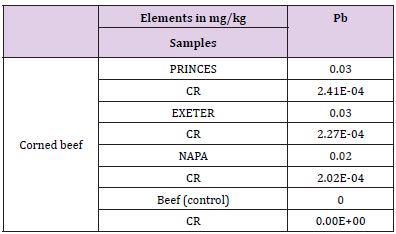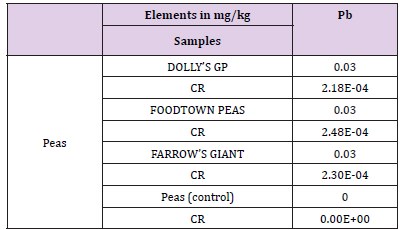Potential Carcinogenic Risk Evaluation of Pb in Selected Canned Foods Obtained from Superstores in Nigeria
In Nigeria, one of the fastest forms of food consumed daily by humans are canned foods. These foods might be beverages, corned beef, peas, mushrooms, chicken and corn prepared in their natural state and preserved in chemicals, engrossed and embossed with lead materials, so that their shelf life will last. This well-known carcinogenic metal Lead (Pb) is pervasive, and one of the first metals revealed by man [1,2]. It is commonly found in air, water, soil and food [3]. Lead is considered as a powerful industrial poison, and its toxicological signs are well acknowledged [4].
The toxicity of lead is commonly graded as the greatest health risk [5]. Canned foods are generally exposed to lead impurity during the process of canning. Solder used in the production of cans has been known as a basis of lead pollution [6]. Several health problems associated with lead poisoning such as damages of the haematopoietic system (the blood), the nervous system and the kidneys thus meddling with their roles [7]. These can result to antagonistic overactive behaviour and psychological delay such seizures and cerebral palsy [8]. This study investigated the potential carcinogenic risks associated with lead (Pb) in some consumed canned foods.
Forty Five (45) samples of five different canned foods (chicken, corned beef, peas, mushrooms and corn) of varied brands and various industrial countries were procured from different local superstores. The brands can be allotted sample codes and the particulars on the containers were recorded based by the methods of Erhunmwunse et al. [9]. The samples were taken to the laboratory for analysis and heavy metal (Pb) digestion. The samples were standardised according to the methods of AOAC [10]. The blank reagent was prepared with same procedure but without samples and the Heavy metal content was read off using AAS Buck Scientific (Model 210 VGP) [11].
Quality Assurance
The equipment was first calibrated using buck certified atomic absorption standards for the respective trace metals to obtain calibration curves. Reagent blanks were first run at intervals of every ten sample analysis to eradicate equipment drift. All samples were analysed in duplicates for reproducibility, accuracy and precision.
Health Risk Assessment
The methods of Wu et al. [11], Iqbal and Shah [13], Liang et al. [14] and Song et al. [15] were used to estimate the exposure dose through ingestion of the food samples in mg/l/d. The modified Carcinogenic Risk (CR) by Wu et al. [11], Iqbal and Shah [13] and De Miguel et al. [16] was used to compute the values gotten in this study. The USEPA, [17] range (1.0E-06 to 1.0E-04) of carcinogenic risks acceptable or tolerable was used in this study.
The summary of the levels of carcinogenic risk via ingestion for Pb in different canned foods (chicken, corned beef, peas, mushrooms and corn) are as shown in Tables 1-5. In the canned chicken (NAPA CHICKEN, ZWAN and KIRLAND) and the control chicken, it was observed that the results obtained for the exposure via ingestion were 0.01, 0.03 0.02 and 0.00 mg/l/d and for the CR (1.17E-04, 2.22E-04, 1.87E-04 and 0.00E+00) respectively (Table 1). The values obtained from the canned chicken differed from the control. For the canned corned beef (PRINCES, EXTER and NAPA) and the control corned beef, it was observed that the results obtained for the exposure via ingestion were 0.03, 0.03 0.02 and 0.00 mg/l/d and for the CR (2.41E-04, 2.27E-04, 2.02E-04 and 0.00E+00) respectively (Table 2). The values obtained from the canned corned beef differed from the control.
Table 1: Summary of the Cancer Risk (CR) for lead (Pb) in selected canned chicken.

Table 2: Summary of the Cancer Risk (CR) for lead (Pb) in selected canned corned beef.

Table 3: Summary of the Cancer Risk (CR) for lead (Pb) in selected canned peas.

Table 4: Summary of the Cancer Risk (CR) for lead (Pb) in selected canned mushroom.

Table 5: Summary of the Cancer Risk (CR) for lead (Pb) in selected canned corn.

In the canned peas (DOLLY’S GP, FOODTOWN PEAS and FARROW’S GIANT) and the control peas, it was observed that the results obtained for the exposure via ingestion were 0.03, 0.03 0.03 and 0.00 mg/l/d and for the CR (2.18E-04, 2.48E-04, 2.30E-04 and 0.00E+00) respectively (Table 3). The values obtained from the canned peas differed from the control. For the canned mushrooms (DIAMOND BELL PIECE and STEM EXTER, TRIO W and MLIANGE MUSHROOM CHIOCE WHOLE) and the control mushroom, it was observed that the results obtained for the exposure via ingestion were 0.02, 0.03 0.03 and 0.00 mg/l/d and for the CR (1.82E-04, 2.50E-04, 2.58E-04 and 0.00E+00) respectively (Table 4). The values obtained from the canned mushrooms differed from the control.
In the canned corns (GREEN GIANT, DOLLY’S SC and SUNRIPE WHOLE) and the control corns, it was observed that the results obtained for the exposure via ingestion were 0.01, 0.03 0.02 and 0.00 and for the CR (2.30E-04, 2.67E-04, 2.83-04 and 0.00E+00) respectively (Table 5). The values obtained from the canned corns differed from the control. Figure 1 shows the variations of Pb concentrations across the sampled canned food brands. The results indicated that almost all canned food brands were lower than the FAO/WHO CODEX limits exempting DOLLY’S SC (1.1 mg/kg) and SUNRIPE WHOLE (1.07 mg/kg).
Figure 1: Comparison between the Lead (Pb) concentrations in varied canned foods with their controls and CODEX limit.

The findings of this study revealed high concentrations of Pb in all the studied food brands exceeding the USEPA, [17] carcinogenic risks acceptable of 1.0E-06 to 1.0E-04. Been a toxic metal and at very little concentration, it can result to health threats because of its non-biodegradable nature in living organism [18]. The occurrence of Pb in canned food may due to use of Pb in product package materials or due to absorbed lead by plants in limit level [1,2,19]. Lead has been found to be carcinogenic and also a probable enzyme inhibitor [20], which interferes with fertility and causes renal damage. It has been confirmed that children under six (6) years of age and expectant mothers are most vulnerable to the serve health effects of lead [21-25]. The findings of this study also revealed that that almost all canned food brands were lower than the FAO/WHO CODEX [26] limit exempting DOLLY’S SWEET CORN and SUNRIPE WHOLE SWEET CORN. Moreover, the Pb concentration in the control corn was BDL (below detectable limits).
The examined canned foods are potentials for a lifetime carcinogenic risk.
Allergic Contact Dermatitis to Clindamycin and Benzoyl Peroxide Resembling “Urticaria/Angioedema”-https://biomedres01.blogspot.com/2020/12/allergic-contact-dermatitis-to.html
More BJSTR Articles : https://biomedres01.blogspot.com


No comments:
Post a Comment
Note: Only a member of this blog may post a comment.